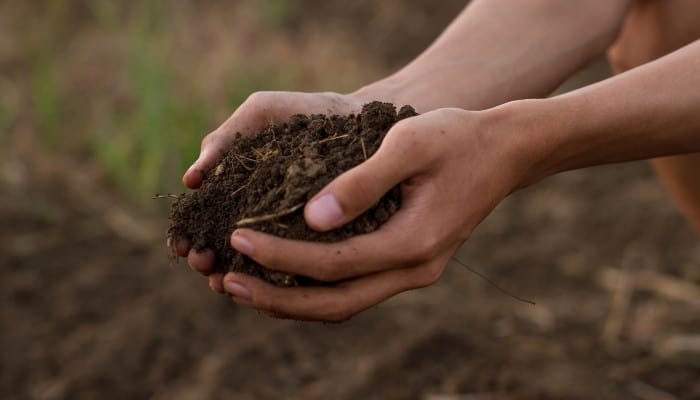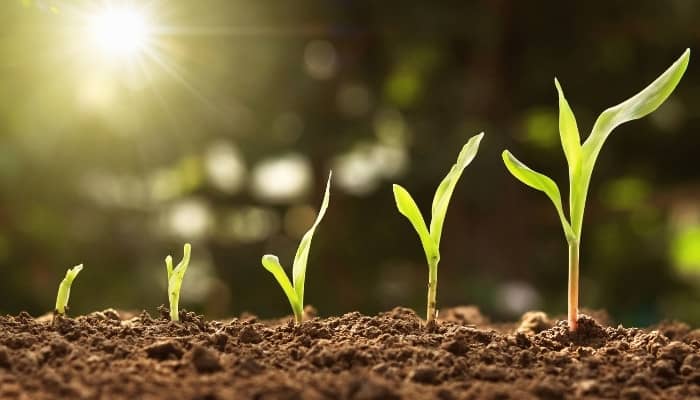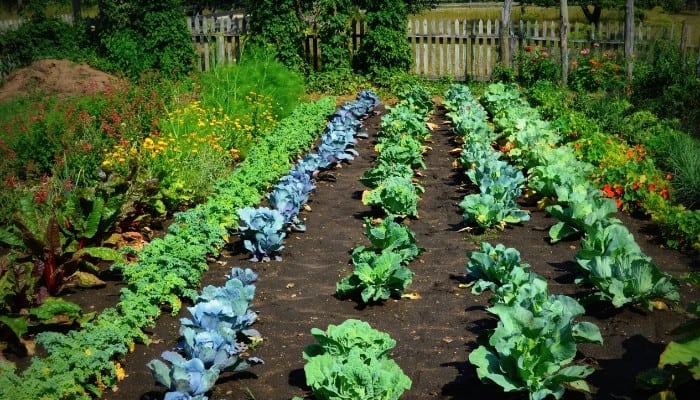If you plant your vegetable seedlings in substandard topsoil, they simply won’t survive. However, enhancing the quality of your topsoil isn’t a complex task, so there’s no need to stress.
However, you do need to have a basic understanding of what you’re doing, or you’re going to make your life unnecessarily hard!
What is the best topsoil for vegetable gardens? Topsoil for vegetable gardens should be amended with compost and organic fertilizer. Whether you’re buying the cheapest or most expensive brand, bagged topsoil will not provide a good growing environment for your veggies by itself. It’s up to you to make some adjustments.
To be honest, it doesn’t make much difference if you buy the cheapest or most expensive bags of topsoil.
You’ll be amending it before putting it out in your garden anyway, so you may as well go for the cheaper stuff. Below, we’ll explain how to improve the existing topsoil in your yard, as well as what to do with store-bought topsoil once you get it home, and you can skim our article on topsoil vs. garden soil for more on this.
Best Topsoil for Vegetable Gardens
The best way to deal with topsoil will depend on your situation.
If you have a large yard where you haven’t covered the earth with decking or tiles, you would want to improve what you already have instead of importing topsoil.
That’s because any topsoil you buy will need improving anyway, so you may as well work with what you have.
But if you’re looking to garden in containers or your topsoil got eroded, then it makes sense to buy some.
Topsoil Basics
First off, I need to make sure we’re working with the same definitions. When someone speaks to you about topsoil, they could be referring to one of two things.
1. The Top Layer of Soil
Most of the plant roots will be here, as well as organic matter like fallen leaves. You may take measures to amend and manage your topsoil to improve it.
2. Purchased Imported Soil
This is also known as “fill dirt” as it is usually purchased to fill in gaps or holes.
If you’re planting veggies in imported topsoil, you will need to amend it with organic matter (like compost) and organic fertilizer (like worm castings).
You can buy it by the bag from garden centers or online, or you can buy it by the truckload from a local landscaping company.
Now we’ve got that sorted out; we can dive a little deeper!
Testing Your Soil
If you want to assess what’s going on with your topsoil, there are a few different tests you might like to carry out.
First off, I wouldn’t bother testing topsoil that you buy in bags. We already know that stuff will need a helping hand, so don’t waste the money on tests.
Remember, you don’t have to do all or even any of these tests, but they will help you save time and energy in the long run by telling you what you need to be improving.
Soil Type Testing
You can carry out a soil type test by yourself, and it won’t cost you anything. This will tell you whether your soil is more “clay,” “sand,” or “silt.”
Or if you’re fortunate, you might have a loam, which offers the best of all three soil types. You can find out how to do this test in this article.
The results will help you understand how to manage your garden best.
Soil Chemistry Testing
People do soil chemistry tests to find out what nutrients they “should” add to their yard. People test for nitrogen, phosphorus, and potash most frequently.
You can do this quickly and inexpensively with a hometesting kit.
You should be aware that adding nitrogen, phosphorus, and potash are ways to address symptoms of a bigger problem, but they don’t get down to the core.
If you have healthy soil with good biology (bacteria and fungi), your plant will have all the nutrients it needs, no matter your soil type.
(Don’t believe me? This world-renowned book has got you covered.)
Other Tests
Other tests that you might want to look into are biological testing, pH testing, and compaction testing.
You’ll find more information in our soil testing article here.
What To Look For
When you’re buying topsoil from a garden center, you don’t need to think about it too much.
All bagged topsoil is pretty junky, because it’s designed to fill in holes more than anything else.
As soon as the soil has been improved with amendments, it’s called “garden soil” or “potting soil” instead.
If you are privately importing topsoil from another site, make sure you check out historic land use because you don’t want any nasty surprises!
However, you can typically trust landscaping companies to give you safe topsoil.
Improving Existing Topsoil

You can improve the topsoil you already have with a few simple strategies. For example:
- Add compost to your garden beds every year.
- Consider adding organic fertilizer – worm castings should do the job!
- Minimize chemical inputs, including inorganic fertilizers (they are salts, which will accumulate over time to the detriment of your soil).
- Minimize compaction by stepping around your veggie beds, and don’t use heavy machinery.
- You don’t need to dig or break up the soil. If you must, do NOT use a tiller. Do it by hand with a pitchfork, and keep it minimal. (Learn more about no-dig gardening in this book).
- Don’t leave the soil bare. Use a mulch or a cover crop to retain moisture and prevent rainfall-related compaction.
Compost
There’s no need to mix in a load of expensive amendments. Compost is your most valuable asset. (That’s why gardeners call it black gold!).
You could make your own or buy some at your garden center. If you’ve got a large garden, buying it in bulk from a landscaping company can make sense.
Worm Castings
You can buy worm castings online, or you can start your own worm bin. It’s really rewarding, but it’ll take 3 to 6 months to get your first harvest of castings.
Recommended All-Purpose Topsoil for Vegetable Gardens
When it comes to topsoil, any one will do. It won’t have any biology or amendments in it anyway, so just go for whatever is cheap and readily available.
So once your topsoil arrives, I would mix it at a rate of 50% topsoil to 40% compost and 10% worm castings.
How much topsoil to add to your mix will depend on the quality of your compost, though, so don’t hesitate to experiment as you gain confidence.
You want to get organic compost because this won’t contain antibiotics.
That means it won’t kill the good bacteria and fungi in your topsoil, so good nutrient cycling can occur without you putting expensive amendments in there.
You don’t need to mix in perlite or peat for growing veggies in the garden. People would do this for plants that you’ll grow in containers.
And most organic gardeners are choosing coco coir over peat now anyway because peat is a nonrenewable resource. Learn more about peat and coco coir here.
Best Topsoil for Flowerbed
Depending on your flowerbeds, you may want to take a slightly different approach to your topsoil.
For raised beds, I recommend that you mix in some wood shavings to your topsoil. If you’re growing desert plants, then you might want to consider upping the drainage in your beds.
You can find more helpful information about making cheap topsoil mixes for different situations in this video:
Best Topsoil for Topdressing Grass Lawns
If you’re going to topdress your lawn, I would keep topsoil out of it altogether.
Topdressing is when you spread a fine layer of compost or another amendment over the top of your grass.
You might want to do this if your lawn is unhealthy but you don’t want to dig it up and start again.
It would be a much more holistic approach than using inorganic fertilizers because you’d be healing the soil rather than giving the plant something to cling onto despite its near-useless environment.
The best thing to topdress with would be good compost. The fresher it is, the more good microbial life will still be alive and kicking.
But you don’t want it when it’s still hot; it should have cooled down to ambient temperatures.
If you can smell any sour, vomit-like, or rancid butter-like smells in your compost – don’t use it!
You could also consider using a liquid amendment such as compost tea or worm casting tea.
Instead of buying the tea, I would make or buy the compost/worm castings and pop them in a hessian sack.
Knead a pound or so in a watering can full of water a for around a minute, then pull out the sack and pour your liquid straight away.
(Make sure it’s a firm kneading action rather than a scouring one, or you could kill off the microbial life as it separates from the castings).
Best Topsoil for Sod
Mixing topsoil with amendments is essential for your sod to do well. We covered amendments in more detail earlier, so refer back to that if you have any doubts.
When it comes to sod, take special care to mix your topsoil with plenty of organic matter, perhaps upping the ratio to 50:50.
You will want your amended topsoil to be up to 6 inches thick if you have very sandy or clay soil, as this will provide the necessary space, support, and oxygen for your sod to root down properly and get well established in your yard.
Best Topsoil for Grass Seed
There’s no magic formula that applies to grass seed alone. So long as you have some decent organic matter and nutrients mixed in with your topsoil, your grass should do just fine.
You want to plant your seeds at a depth of ⅛ to ¼ of an inch below the surface.
Grass seed is fine and light, so you don’t want to dump a thick layer of topsoil on top, or it will struggle to make it out of the surface.
Frequently Asked Questions

How Thick Should Topsoil Be?
Topsoil takes hundreds of years to form, but it can be wiped out in a single storm if it isn’t being looked after correctly. The thicker your topsoil, the better!
If you buy topsoil to use in your yard, you probably want it to be between 1 and 2 inches thick minimum, but I’d go as deep as 5 inches for sod.
Can You Use Topsoil as Fill Dirt?
Yes, you can use topsoil as fill dirt. It would be a waste of money and resources to fill holes with expensive and nutritious potting mixes.
But you can upgrade your topsoil with some simple amendments if you would like to use it in your vegetable garden.
Can You Use Topsoil in Raised Beds?
Yes, you can use topsoil to fill raised beds. If you do, I recommend that you amend it with compost and wood shavings.
Check out the video I suggested earlier in this article for more information.
What’s the Difference Between Topsoil and Compost?
Compost is known as black gold. It’s rich, decomposed organic matter that is full of nutrients and beneficial microorganisms (if it’s done correctly).
Topsoil is the top layer of your yard or the cheapest dirt that you can buy in sacks. You can improve it with compost.
Can You Plant Directly in Topsoil?
Topsoil can refer to the top layer of the soil where you plant your seeds and seedlings, but it can also refer to basic soil that you import to fill containers or holes in your yard.
If you have just imported some topsoil, you’ll need to amend it with some compost and possibly worm castings before planting.
If the topsoil in your garden is in great condition, you can go ahead and plant straight into it.
Final Thoughts
I know that learning about soil can feel like a bit of a minefield.
Not only must you contend with all the different kinds of soil in the garden center, but you’re also going to hear a lot of conflicting advice.
Some people will insist you need tons of chemical (and expensive) inputs, and some people (like me) will tell you to tread lightly because less is more when it comes to your garden.
It’s okay for you to discount some of my advice and take the path that feels right for you.
Gardening isn’t an exact science but rather a labor of love and practical experience. So have fun, and don’t hesitate to switch things up until you find what works best for you.
I hope you found this article helpful, and I wish you many happy days with your hands in the dirt!

